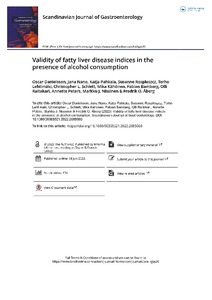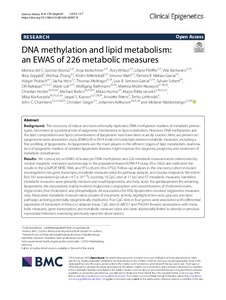Hae
Aineistot 1-4 / 4
Genome-wide association studies identify 137 genetic loci for DNA methylation biomarkers of aging
<p>Background Biological aging estimators derived from DNA methylation data are heritable and correlate with morbidity and mortality. Consequently, identification of genetic and environmental contributors to the variation ...
Methylation status of nc886 epiallele reflects periconceptional conditions and is associated with glucose metabolism through nc886 RNAs
<p>Background</p><p>Non-coding RNA 886 (nc886) is coded from a maternally inherited metastable epiallele. We set out to investigate the determinants and dynamics of the methylation pattern at the nc886 epiallele and how ...
Validity of fatty liver disease indices in the presence of alcohol consumption
<p><strong>Background & aims: </strong>Non-alcoholic fatty liver disease (NAFLD) and alcohol-related liver disease frequently coexist. While several blood-based indices exist for the detection of NAFLD, few studies have examined how alcohol use possibly impacts their diagnostic performance. We analysed the effects of alcohol use on the performance of indices for detecting fatty liver disease (FLD).</p><p><strong>Methods: </strong>We included participants from the Cardiovascular Risk in Young Finns Study (Finnish sample) and KORA study (German sample) who underwent abdominal ultrasound or magnetic resonance imaging, respectively, for detection of FLD and had serum analyses available for calculation of Fatty Liver Index (FLI), Hepatic Steatosis Index (HSI), Lipid Accumulation Product (LAP), and Dallas Steatosis Index (DSI). Alcohol use was estimated by questionnaires as mean daily consumption and binge drinking (Finnish sample only). Predictive performance for FLD was assessed according to alcohol consumption.</p><p><strong>Results: </strong>The study included 1426 (Finnish sample) and 385 (German sample) individuals, of which 234 (16%) and 168 (44%) had FLD by imaging. When alcohol consumption was <50 g/day, all indices discriminated FLD with area under the receiver operating characteristics (AUROC) of 0.82-0.88. AUROCs were 0.61-0.66 among heavy drinkers (>50 g/day). AUROCs decreased to 0.74-0.80 in the highest binge-drinking category (>2 times/week). Alcohol use correlated with FLI and LAP (r-range 0.09-0.16, p-range <.001-.02) in both samples and with DSI (r = 0.13, p < .001) in the Finnish sample.</p><p><strong>Conclusions: </strong>Indices perform well and comparably for detection of FLD with alcohol consumption <50 g/day and with different binge-drinking behaviour.</p>...
DNA methylation and lipid metabolism: an EWAS of 226 metabolic measures
<p>Background: The discovery of robust and trans-ethnically replicated DNA methylation markers of metabolic phenotypes, has hinted at a potential role of epigenetic mechanisms in lipid metabolism. However, DNA methylation and the lipid compositions and lipid concentrations of lipoprotein sizes have been scarcely studied. Here, we present an epigenome-wide association study (EWAS) (N = 5414 total) of mostly lipid-related metabolic measures, including a fine profiling of lipoproteins. As lipoproteins are the main players in the different stages of lipid metabolism, examination of epigenetic markers of detailed lipoprotein features might improve the diagnosis, prognosis, and treatment of metabolic disturbances.<br></p><p>Results: We conducted an EWAS of leukocyte DNA methylation and 226 metabolic measurements determined by nuclear magnetic resonance spectroscopy in the population-based KORA F4 study (N = 1662) and replicated the results in the LOLIPOP, NFBC1966, and YFS cohorts (N = 3752). Follow-up analyses in the discovery cohort included investigations into gene transcripts, metabolic-measure ratios for pathway analysis, and disease endpoints. We identified 161 associations (p value < 4.7 x 10<sup>-10</sup>), covering 16 CpG sites at 11 loci and 57 metabolic measures. Identified metabolic measures were primarily medium and small lipoproteins, and fatty acids. For apolipoprotein B-containing lipoproteins, the associations mainly involved triglyceride composition and concentrations of cholesterol esters, triglycerides, free cholesterol, and phospholipids. All associations for HDL lipoproteins involved triglyceride measures only. Associated metabolic measure ratios, proxies of enzymatic activity, highlight amino acid, glucose, and lipid pathways as being potentially epigenetically implicated. Five CpG sites in four genes were associated with differential expression of transcripts in blood or adipose tissue. CpG sites in ABCG1 and PHGDH showed associations with metabolic measures, gene transcription, and metabolic measure ratios and were additionally linked to obesity or previous myocardial infarction, extending previously reported observations.<br></p><p>Conclusion: Our study provides evidence of a link between DNA methylation and the lipid compositions and lipid concentrations of different lipoprotein size subclasses, thus offering in-depth insights into well-known associations of DNA methylation with total serum lipids. The results support detailed profiling of lipid metabolism to improve the molecular understanding of dyslipidemia and related disease mechanisms.</p>...



